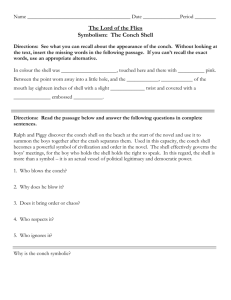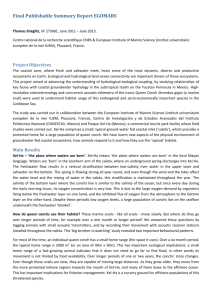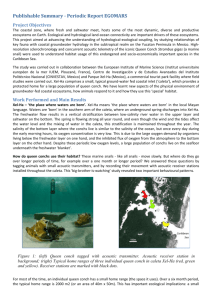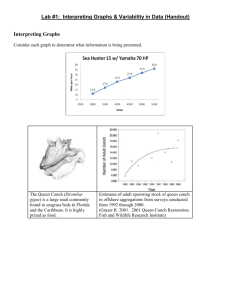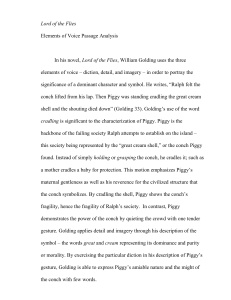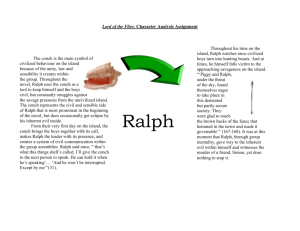Queen Conch Sea Stat
advertisement
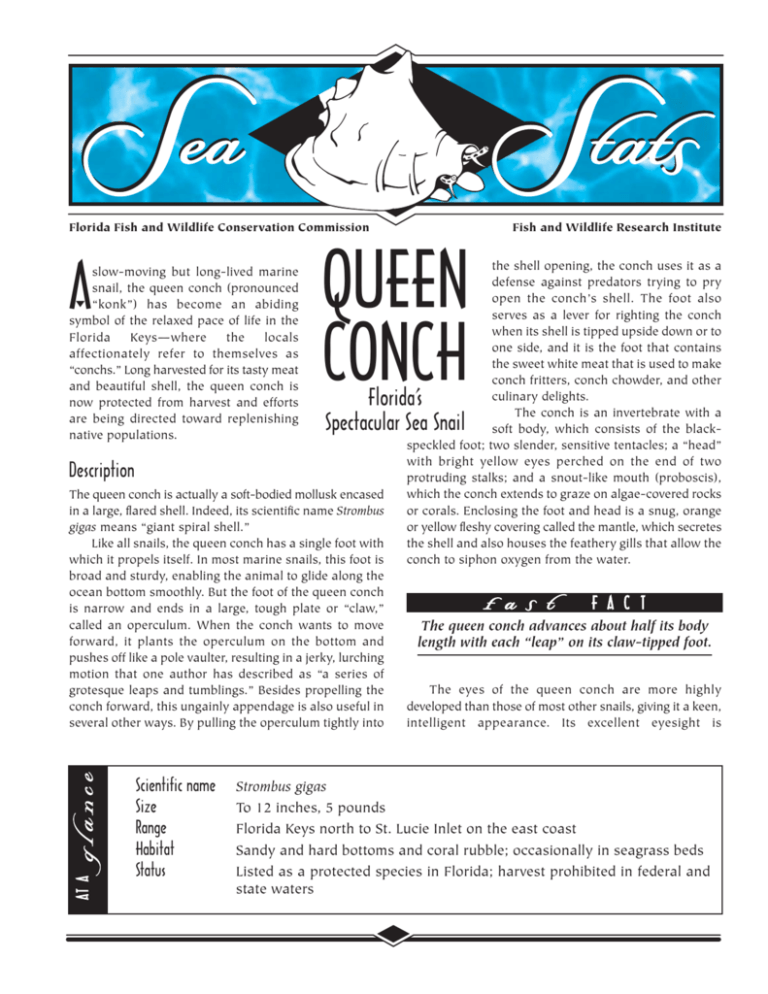
Florida Fish and Wildlife Conservation Commission A slow-moving but long-lived marine snail, the queen conch (pronounced “konk”) has become an abiding symbol of the relaxed pace of life in the Florida Keys—where the locals affectionately refer to themselves as “conchs.” Long harvested for its tasty meat and beautiful shell, the queen conch is now protected from harvest and efforts are being directed toward replenishing native populations. QUEEN CONCH the shell opening, the conch uses it as a defense against predators trying to pry open the conch’s shell. The foot also serves as a lever for righting the conch when its shell is tipped upside down or to one side, and it is the foot that contains the sweet white meat that is used to make conch fritters, conch chowder, and other culinary delights. The conch is an invertebrate with a soft body, which consists of the blackspeckled foot; two slender, sensitive tentacles; a “head” with bright yellow eyes perched on the end of two protruding stalks; and a snout-like mouth (proboscis), which the conch extends to graze on algae-covered rocks or corals. Enclosing the foot and head is a snug, orange or yellow fleshy covering called the mantle, which secretes the shell and also houses the feathery gills that allow the conch to siphon oxygen from the water. Florida’s Spectacular Sea Snail Description The queen conch is actually a soft-bodied mollusk encased in a large, flared shell. Indeed, its scientific name Strombus gigas means “giant spiral shell.” Like all snails, the queen conch has a single foot with which it propels itself. In most marine snails, this foot is broad and sturdy, enabling the animal to glide along the ocean bottom smoothly. But the foot of the queen conch is narrow and ends in a large, tough plate or “claw,” called an operculum. When the conch wants to move forward, it plants the operculum on the bottom and pushes off like a pole vaulter, resulting in a jerky, lurching motion that one author has described as “a series of grotesque leaps and tumblings.” Besides propelling the conch forward, this ungainly appendage is also useful in several other ways. By pulling the operculum tightly into Scientific name Size Range Habitat Status Fish and Wildlife Research Institute The queen conch advances about half its body length with each “leap” on its claw-tipped foot. The eyes of the queen conch are more highly developed than those of most other snails, giving it a keen, intelligent appearance. Its excellent eyesight is Strombus gigas To 12 inches, 5 pounds Florida Keys north to St. Lucie Inlet on the east coast Sandy and hard bottoms and coral rubble; occasionally in seagrass beds Listed as a protected species in Florida; harvest prohibited in federal and state waters supplemented by its tentacles, which are also used to feel and taste the water. The blood of the queen conch is a colorless liquid called hemocyanin, which contains copper. It is similar to the iron-containing hemoglobin in vertebrate animals. In the process of respiration, oxygen turns the hemocyanin blue—making queen conchs true “bluebloods” of the animal kingdom. The queen conch’s shell is its most striking feature. Adults have a heavy shell with a broad, flared lip that is a glossy pink, orange, or yellow on the interior. The outside of the shell is marked by a blunt crown of spines that project from each whorl of the spiral. Queen conchs are “right-handed,” meaning that as the observer looks at the pointed crown, the spiral coils to the right. A brown, papery layer called the periostracum covers the shell and collects silt, bacteria, and algae, which help to disguise the animal. The periostracum flakes off when the shell is removed from the water and dried. A queen conch shell can be as long as 12 inches and weigh as much as 5 pounds. In Bermuda, queen conchs may live 40 years, but in Florida their life span is estimated at 7 to 15 years. Queen conchs are among the largest gastropods (or snail-like animals) in the sea. Females are slightly larger than males of the same age, but both may increase their shell length by as much as three inches a year during their active growing stage. After the animal attains sexual maturity, its shell continues to thicken, but its lengthwise growth stops. Range and Habitat The queen conch is found off Bermuda, the Bahamas, and throughout the entire Caribbean. Of the 55 species of conchs worldwide, six occur in Caribbean and Florida waters. Conchs are usually found in warm, shallow waters. Although they have been found in waters 500 feet deep, they are most abundant in waters ranging from 1 to 70 feet deep. Despite their painstakingly slow speed, conchs may wander for miles foraging on algae-encrusted rocks or decaying organic matter. Tagging studies in Florida show that queen conch may travel up to 100 yards in two weeks and have home ranges of up to 150 acres. In Florida, queen conchs are most abundant in the Florida Keys but are occasionally found as far north as St. Lucie Inlet on the east coast. Adults are found most often in coral rubble and in hard-bottom communities of soft corals and sponges, but they may also take up residence on sandy bottoms and in seagrass beds. From April to October, adult conchs gather to spawn offshore Adult female conch without her shell Art after B. D. Egan, 1985. MS thesis, University of British Columbia. 2 in large colonies of up to 10,000 individuals. The large shell of the queen conch accommodates a variety of other creatures. Pink cardinal fish (conch fish) often take up residence within this spacious “mobile” home, and slipper limpets—a type of snail—attach themselves to the shell’s exterior. A small crab can also find comfortable living quarters when wedged between the shell and the conch’s foot. Queen conchs typically mate in the summer or early fall in shallow, sandy areas behind the reefs. During mating, the male sits behind the female and deposits sperm into the female. The female may retain the sperm for several weeks, and fertilization is internal. Some females may spawn six to eight times during each spawning season. The egg cases are released as a mass of tightly wound gelatinous tubes that contain about 400,000 embryos. Life History Egg mass Conchs begin life as creatures so small they can be seen only with a microscope. These larvae, or “veligers,” bear no resemblance to the final product. A veliger has two wing-like lobes covered with bristly stubble called cilia— which help it swim and direct food to its mouth—and a tiny, transparent shell that will Veliger larva eventually become the familiar curved adornment of the mature queen conch. The larvae grow new lobes as they mature. By the fourth day of life, the veliger has four of these lobes; by the end of its first week, it has six. Veligers spend the first 21 days of their existence drifting and swimming in the ocean currents, feeding on tiny, one-celled plants called phytoplankton. Then they settle to the sea floor, the lobes disappear, and the “foot” and snout-like mouth develop. Within a month, the animal begins to take on the appearance of an adult conch in miniature as it adds to its shell by secreting liquid calcium carbonate that quickly hardens into crystals. Conchs measure about three inches in length at one year of age and about six inches by the second year. These young conchs are called “rollers” because their shells do not yet have the stable, flaring lip of adults. They feed on the algae and decaying plant matter that clings to seagrass blades. When the juvenile’s shell is about 9.5 to 12 inches long, the lip forms and the shell stops growing in size and length. Instead, the conch directs its energy to strengthening the shell and lip, so that the shell becomes thicker and heavier while the animal inside actually becomes smaller. This process usually occurs, particularly in offshore groups, during the third year. However, some nearshore conch populations in Florida develop the flared lip in their second year. The animal reaches sexual maturity only after the lip is well developed. Section of egg strand about 6 inches long From 70 to more than 120 feet of tube strands may be produced at a rate of about 5 feet per hour. After four to five days, the embryos emerge from the egg cases as larval veligers and may be carried great distances by currents before settling to the ocean floor and beginning their conch development in earnest. Very few will survive to adulthood. Veligers are eaten by other small, swimming creatures, and the fragile shells of juvenile conchs make them easy prey for crabs, sharks, rays, groupers, and tulip shells. Spiny lobsters and porcupine, or puffer, fish are among a juvenile conch’s greatest threats. Once the conch reaches adulthood, however, few animals can prey upon it, although adults may still be eaten by loggerhead sea turtles and horse conchs—as well as by humans. Economic Importance Queen conchs have been part of the human diet for centuries. Prehistoric Indians who lived in south Florida 3,000 years ago ate conch meat and used the shells to make cooking utensils and pots, as well as necklaces, pendants, earrings, and buttons. Intact shells also functioned as ceremonial items and trumpets, a use that still finds a following today among islanders with a penchant for unusual musical instruments. English explorers took conch shells home with them, and the shells quickly became a coveted novelty. By the 17th century, pink conch shells adorned nearly every fireplace mantel and were used as decorative edging in English gardens. The shells were also carved into cameos and were ground to make a high-quality porcelain. In more 3 modern times, conch shells were used as the foundation for road beds. if management plans are not enacted appropriately. In Florida, scientists with the Fish and Wildlife Conservation Commission’s Fish and Wildlife Research Institute (FWRI) have studied methods to restore conch populations to sustainable levels. Researchers first examined producing conch in hatcheries and releasing them under optimal conditions. However, the high cost of production coupled with the high natural mortality rates of conch in the wild made this approach very expensive. An alternative restoration strategy was soon developed using a simpler concept. During many years of monitoring conch populations, FWRI scientists established that nearshore conch do not reproduce—all reproduction takes place offshore. In fact, scientists discovered that nearshore conch are physiologically incapable of reproduction. Furthermore, these nearshore conch cannot migrate offshore because of a natural barrier, Hawk Channel, which is poor habitat quality. Yet, larvae produced offshore can ride the currents and settle nearshore. However, when transplanted into offshore spawning aggregations, these same conch become reproductively viable and were mating and spawning after only 6 months. Through summer 2005, scientists and volunteers have transplanted nearly 2,500 nearshore conch to three offshore sites in the Lower Florida Keys. The conch population in Florida remained suppressed for at least a decade after the 1985 net ban; however, surveys indicate that the conch population is beginning to recover. The offshore population of conch in Florida is estimated to be about 100,000. About half of these offshore conch are adults and thus sexually mature and reproductively active. Conch breeding populations in the Florida Keys have steadily increased, especially since 1999. Conch populations in the Lower Florida Keys have traditionally been the largest and probably provide the majority of the conch larvae supplying south Florida. Research is now focused on understanding the factors that are limiting the reproduction and survival of conchs in nearshore waters of Florida. Scientists are also studying how many larvae “recruit” into Florida waters from other areas, such as Cuba and Mexico. Additionally, tracking studies utilizing sonic tags that emit sound frequencies assist researchers to learn how transplanted conch interact with native offshore conch. Older, heavier conchs were once considered a separate species and called “sambas.” About one in 10,000 conchs contains rare pearls, formed when an irritant invades the conch’s mantle. These very expensive baubles, pink or brown and sometimes with flame-like striations, are in great demand by jewelers and are obtained from areas of the Caribbean where conch harvests still occur. However, the colors of the pearls tend to fade with time. Conch has long been a staple food item in the Caribbean, although its meat is tough and usually must be ground, pounded, or marinated in lime juice to be made tender. In Florida, conchs were harvested mainly as curios, until a 1965 law mandated that fishermen utilize the meat as well as the shell. In the early days of the conch fishery, fishermen in small dinghies used glass-bottom buckets to scan the bottom for conchs and retrieved the animals with long, hooked poles. The fishermen often brought the conchs to port alive and cleaned them by knocking a hole between the third and fourth whorl of the shell and inserting a knife to separate the animal from the shell. About one-fifth to one-third of the weight of an adult conch is edible meat. At one time, queen conchs were so plentiful and widely used that long-time natives of the Florida Keys were known as “conchs,” a nickname still in use today. Management Efforts The advent of scuba gear made conch harvesting easier, and by 1966, between 200,000 and 250,000 conchs per year were landed in Key West. In 1978, Florida officials placed a moratorium on commercial harvests, followed in 1985 by a complete ban on all harvests. A year later, queen conch harvests in federal waters were closed. The queen conch is now listed in Florida as a protected species. It is recognized by CITES, an international conservation and trade authority, as a species that may become threatened May 2006 Florida Fish and Wildlife Conservation Commission, Fish and Wildlife Research Institute 100 8th Avenue SE, St. Petersburg, FL 33701 • (727) 896-8626 • http://research.MyFWC.com 4

